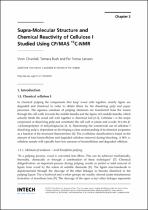 ResearchSpace
ResearchSpace
Supra-molecular structure and chemical reactivity of cellulose I studied using CP/MAS (sup)13 C-NMR
JavaScript is disabled for your browser. Some features of this site may not work without it.
- ResearchSpace
- →
- Research Publications/Outputs
- →
- Book Chapters
- →
- View Item
| dc.contributor.author |
Chunilall, Viren

|
|
| dc.contributor.author |
Bush, T

|
|
| dc.contributor.author |
Larsson, PT

|
|
| dc.date.accessioned | 2013-09-30T08:05:20Z | |
| dc.date.available | 2013-09-30T08:05:20Z | |
| dc.date.issued | 2013-08 | |
| dc.identifier.citation | Chunilall, V, Bush, T and Larsson, P.T. 2013. Supra-molecular structure and chemical reactivity of cellulose I studied using CP/MAS (sup)13 C-NMR. In: Cellulose – Fundamental Aspects. Intech publishing: Manhattan, New York, pp 69-90 | en_US |
| dc.identifier.isbn | 978-953-51-1183-2 | |
| dc.identifier.uri | http://cdn.intechopen.com/pdfs/45616/InTech-Supra_molecular_structure_and_chemical_reactivity_of_cellulose_i_studied_using_cp_mas_13c_nmr.pdf | |
| dc.identifier.uri | http://hdl.handle.net/10204/6968 | |
| dc.description | Copyright: Intech Publishing, Manhattan, New York | en_US |
| dc.description.abstract | In chemical pulping the components that keep wood cells together, mainly lignin are degraded and dissolved in order to obtain fibres for the dissolving pulp and paper processes. The aqueous solutions of pulping chemicals are transferred from the lumen through the cell walls towards the middle lamella and the lignin rich middle lamella, which actually binds the wood cell wall together is dissolved last. Cellulose I is the major component of dissolving pulp and constitutes the cell wall of plants and woods. It is the b-1,4-homopolymer of anhydroglucose. Maximising the commercial use of cellulose I dissolving pulp is dependent on developing a clear understanding of its chemical properties as a function of the structural characteristics. The a-cellulose classification is based on the amount of total hemicellulose and degraded cellulose removed during bleaching. A 96% a- cellulose sample will typically have low amounts of hemicellulose and degraded cellulose. | en_US |
| dc.language.iso | en | en_US |
| dc.publisher | Intech Publishing | en_US |
| dc.relation.ispartofseries | Worklist;11486 | |
| dc.subject | Supra-molecular structure | en_US |
| dc.subject | Chemical reactivity | en_US |
| dc.subject | Cellullose I | en_US |
| dc.subject | Solid state NMR | en_US |
| dc.title | Supra-molecular structure and chemical reactivity of cellulose I studied using CP/MAS (sup)13 C-NMR | en_US |
| dc.type | Book Chapter | en_US |
| dc.identifier.apacitation | Chunilall, V., Bush, T., & Larsson, P. (2013). Supra-Molecular structure and chemical reactivity of cellulose I studied using CP/MAS (sup)13 C-NMR., <i>Worklist;11486</i> Intech Publishing. http://hdl.handle.net/10204/6968 | en_ZA |
| dc.identifier.chicagocitation | Chunilall, Viren, T Bush, and PT Larsson. "Supra-molecular structure and chemical reactivity of cellulose I studied using CP/MAS (sup)13 C-NMR" In <i>WORKLIST;11486</i>, n.p.: Intech Publishing. 2013. http://hdl.handle.net/10204/6968. | en_ZA |
| dc.identifier.vancouvercitation | Chunilall V, Bush T, Larsson P. Supra-molecular structure and chemical reactivity of cellulose I studied using CP/MAS (sup)13 C-NMR.. Worklist;11486. [place unknown]: Intech Publishing; 2013. [cited yyyy month dd]. http://hdl.handle.net/10204/6968. | en_ZA |
| dc.identifier.ris | TY - Book Chapter AU - Chunilall, Viren AU - Bush, T AU - Larsson, PT AB - In chemical pulping the components that keep wood cells together, mainly lignin are degraded and dissolved in order to obtain fibres for the dissolving pulp and paper processes. The aqueous solutions of pulping chemicals are transferred from the lumen through the cell walls towards the middle lamella and the lignin rich middle lamella, which actually binds the wood cell wall together is dissolved last. Cellulose I is the major component of dissolving pulp and constitutes the cell wall of plants and woods. It is the b-1,4-homopolymer of anhydroglucose. Maximising the commercial use of cellulose I dissolving pulp is dependent on developing a clear understanding of its chemical properties as a function of the structural characteristics. The a-cellulose classification is based on the amount of total hemicellulose and degraded cellulose removed during bleaching. A 96% a- cellulose sample will typically have low amounts of hemicellulose and degraded cellulose. DA - 2013-08 DB - ResearchSpace DP - CSIR KW - Supra-molecular structure KW - Chemical reactivity KW - Cellullose I KW - Solid state NMR LK - https://researchspace.csir.co.za PY - 2013 SM - 978-953-51-1183-2 T1 - Supra-molecular structure and chemical reactivity of cellulose I studied using CP/MAS (sup)13 C-NMR TI - Supra-molecular structure and chemical reactivity of cellulose I studied using CP/MAS (sup)13 C-NMR UR - http://hdl.handle.net/10204/6968 ER - | en_ZA |





